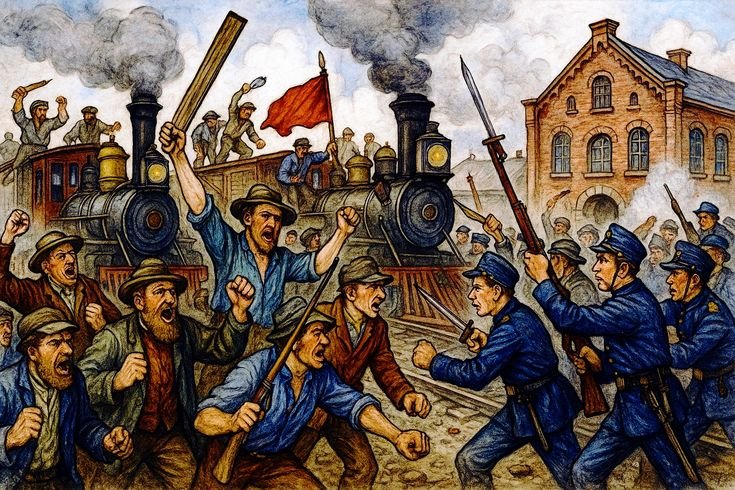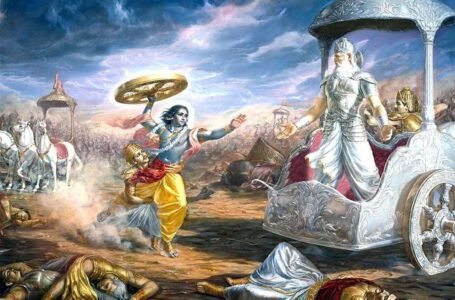The Strikes That Shook Nations: Major Worker Uprisings That Changed Modern History

-Mili Joshi
The workers, being the spine of every industry, economy, and society, have often been the starting point of real human change in history. When the wages were such that they didn’t even begin to make up for their labour, when workdays became unbearably long, and when working conditions crossed the line from difficult to unbearable, workers stood up and said, “Enough.” And so, their struggle was carried not just into factories and fields but to the very heart of the cities, halting production and disrupting daily lives in their demand for justice. Some of those strikes entered the books of history in mere weeks, crushed by sheer force or forgotten by the thick haze of the news cycle. But others, buoyed by solidarity and outrage fuelled some of the strangest and strongest movements that completely reshaped national laws, transformed labour rights, and forever altered the way things are made, lived, and organized in the world. This is the story of a few of those historic strikes: brave uprisings that shook entire nations and have left legacies that still have significance for today’s world of work.
The Great Railroad Strike of 1877: America’s First National Strike
American railroad workers in July of the year 1877 reached their breaking point. The country was in deep recession, teetering on the verge of being depressed, and the main companies had now cut wages for the third time within the year instead of costs. That last blow led to walkouts beginning in Martinsburg, West Virginia, and advancing to millions within a few weeks. Freight trains halted mid-journey, depots went up in flames, and entire cities ground to a stop as workers took to the streets, fed up with being pushed to the brink. In a historic move, President Rutherford B. Hayes deployed federal troops to suppress the uprising-the first time in U.S. history that military force broke a nationwide labour strike. Violence was very gross; more than 100 people were killed in violence. However, the strike served not to regain wages but became a watershed in American labour history. Probably for the first time ever on such a scale, it demonstrated the sheer power of coordinated working-class resistance. Out of its ashes germinated the seeds of future labour unions like the American Federation of Labor-and one powerful and enduring message: ignored, exploited for long enough, the workforce could bring an entire nation to a standstill.
The Matchgirls’ Strike of 1888: Women Take a Stand
Strikes not only vibrated railroads and factories but also sparked something in the match industry of East London where some of the least noticed workers were very young girls. In 1888, more than 1400 women and young girls at Bryant & May match factory lived under horrifying conditions with very bad salaries while being continually exposed to white phosphorus-a substance poisonous because it bore “phossy jaw”, an awful and often fatal disease, slowly chewing one’s jaw bone into decay. After years of silent but furious suffering, these women finally took stand and walked off in anger demanding better pay and safer working environments. The girls stood up all these while for a period of three long weeks despite threats, sardonic insights, and increased pressure from factory owners.
Public support began to swell behind them, which then forced the factory to give in. Not only was it their personal victory but also a very strong message that when united, even the youngest and poorest workers could fight for justice. The Matchgirls’ Strike has become the turning point in labour history as such a force would inspire future movements and open up opportunities for more women to organize and fight for their rights.
The Russian Revolution Begins: 1905 and 1917 Strikes
The power of strikes can shake empires and in Russia, they did just that. In 1905, tens of thousands of workers peacefully marched toward the Tsar’s Winter Palace, demanding better wages, fair treatment, and the end of autocratic rule. Instead, bullets found their mark on the procession soldiers fired into the crowd, killing and wounding hundreds on what became known as Bloody Sunday. The massacre ignited strikes and uprisings across the country, signalling the onset of the 1905 Revolution. Incredibly, Tsarism survived, but the disturbances forced the hand of the monarch, who was then compelled to introduce very limited reforms, which nurtured even greater seeds of resistance. Less than a decade later, in 1917, workers and soldiers again poured into the streets, with no intention of stopping after years of wars, hunger, and oppression. Massive strikes held cities, and the Tsar abdicated with the collapse of the Russian Empire. The chain of events from workers’ protests to revolution that created the Soviet Union proved that when workers unite, they can shake a nation from its very foundations.
The 1936–37 Flint Sit-Down Strike: The Birth of Auto Unions
In that decade during the Great Depression, as labour unrest grew ever larger throughout the breadth of the United States, one of its most well-known scenes became played out in Flint, Michigan. There the workers at General Motors demanded recognition of the United Auto Workers’ (UAW) union, not in the form of what many would call a “normal” strike, but rather by a daring sit-down protest. They occupied the plant for 44 days, sleeping on car seats, holding meals right there on the assembly lines they were accustomed to. Hired thugs and cops did not work to shoo them away. In the end, they got their recognition from GM finally: the UAW was given recognition. With this victory in the sit-down, the method was seen in many places in other industries, and basically put into the lexicon; it stands as a power in negotiating with workers. It was a further defining victory for the American labour movement that helped millions attain rights to get fair wages, better conditions of work, and right to organize themselves.
India’s Railway Strike of 1974: A Nation on Pause
The largest stroke in India took place in May 1974. Around 1.7 million railway workers went on strike demanding better pay and working conditions. The strike was a nationwide work stoppage by the leader of the union, George Fernandes, that paralyzed trains across the length and breadth of the country. The government took it as a threat, thousands of workers were arrested, and troops took over the railways. It lasted for twenty days and did not meet all demands. Yet, it showed the strength of the labor force in India and highlighted the deficiencies in the governing body regarding the handling of dissent. Most historians figure it as one among many reasons that brought about the declaration of the Emergency in India (1975-77), during which civil liberties were suspended. The strike showed how strong organized labor could be even in the face of state power.
Solidarity in Poland: A Strike that Broke a Regime
In 1980, workers from the shipyard of Gdańsk in Poland contributed a new prototype to the political arena. Food prices were going up. Deteriorating working conditions were being rendered untenable. Under the aegis of their leader-elect electrician Lech Wałęsa, the workers occupied the shipyard. They formed Solidarity, the first independent trade union within a Communist bloc. The movement spread like a grease fire. Over 10 million Poles joined Solidarity. The government imposed martial law to put it down. But the strikes nurtured the seeds of freedom. In 1989, Solidarity terminated the power of Communism in Poland, leading other rogue Eastern blocs to take heart from it. From a strike to a bloodless revolt.
The UK Miners’ Strike of 1984–85: A Fight That Defined an Era
Coal miners had long been an incredibly powerful force in this country, but the miners now rose in fierce opposition against the Thatcher government, which had announced plans to close dozens of unprofitable mines. The strike, led by Scargill, lasted for almost a year and was filled with intense rancour, violent clashes, and immense divisions that ran through communities and families. Countless families were plunged into hardship with the lack of wages; the rights of police were challenged as battles with picketers consumed the streets. In spite of the miners losing in the end and the closures going ahead, the strike brought a tectonic shift to Britain’s labour landscape, heralding a period of sharp decline of union power for decades to come. But even in loss, there are stories of solidarity, sacrifice, and the great price exacted by resisting a system bent on breaking the back of organized labour.
Modern Strikes: Lessons Still Echo
Strikes are not mere stories of the past; rather, they continue to encroach on the present and future with their manifestations. From the Amazon warehouse walkouts to regional strikes by teachers in the USA and Europe, contemporary workers are still raising their voices for fair pay, better conditions, and basic respect. After all, in 2019, thousands of Google employees walked out across the globe to protest harassment and inequality in their workplaces, symbolizing to the tech-driven industry that disruption is indeed a potent tool. During the COVID-19 pandemic, the world was reminded by those very important workers nurses, delivery drivers, grocery clerks that without them, society could not continue to function. They, too, went on strike and then threatened to strike for not doing enough to protect employees from the virus and compensate them fairly, thereby proving their worth through action. These new movements are not circumscribed from the troubles far in history; they are firmly planted at the end of generations gone by, and these generations filled streets, factories, and fields and fought for dignity. The strategy, the chant, and the feeling of togetherness hark back, standing as a reminder that every fight for justice leaves behind, at the very least, lessons and momentum.
Why Strikes Matter
Strikes are difficult, involving the non-issuance of pay checks, sleepless nights, fractured communities, and the very real chance of violence or even a loss of life. Yet it is within this crucible of suffering and risk that every wholesome transformation since the beginning of time has been forged. Some of the laws we take for granted today-such as the prohibition of child labour, safety in the workplace, fair compensation, health protection, and the two-day weekend-were won and earned by workers sacrificing and standing together against authority. The strike sends a very strong message to the world: economies rely-not only on capital but also on human beings, their time, energy, and dignity. And when workers choose to reclaim that power by withholding labour, they are teaching the world that it is those human hands, not imagined profit margins, that bring the wheels of history into motion.
The Spirit Lives On
Labor movements have ushered in a new innings of challenges-the beauty of which has nothing to do with coal dust or factory fumes; rather, the troubles they face are because algorithms, automation, and very often the precariousness of work offered digitally know them today. They are shouting out for the very benefits that full-time workers in traditional employment receive; they are revolting against the continuous surveillance and performance quotas that warehouse workers thrive on. Across these industries, understanding the core issues and calling for those flexible conditions, fair wages, and decent treatment at the workplace within a labour market that sees them as data points exemplifies the struggles within labour. The fight has changed, but it’s far from over-or perhaps it’s never really over. The echoes of the Great Railroad Strike, the Matchgirls’ Rebellion, the Solidarity Movement, and all their countless predecessors still remind us of a powerful truth: when workers stand together, they can halt machines, shake governments, and, at times, rewrite the course of history.


